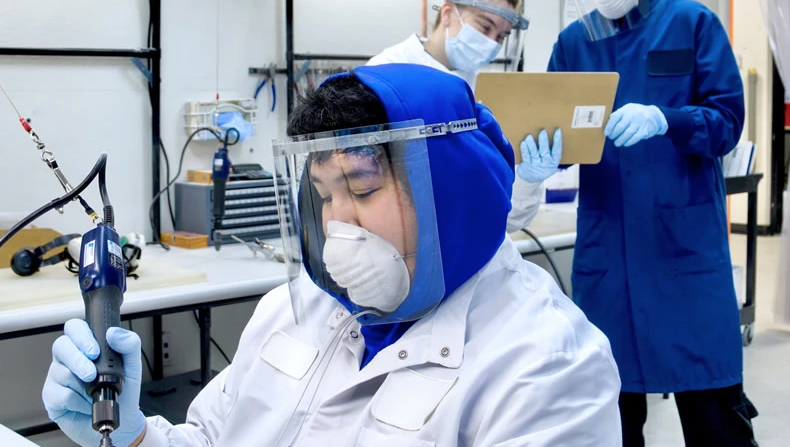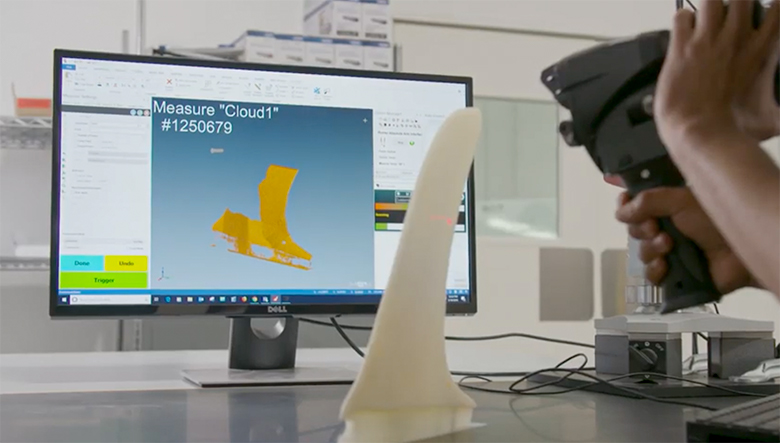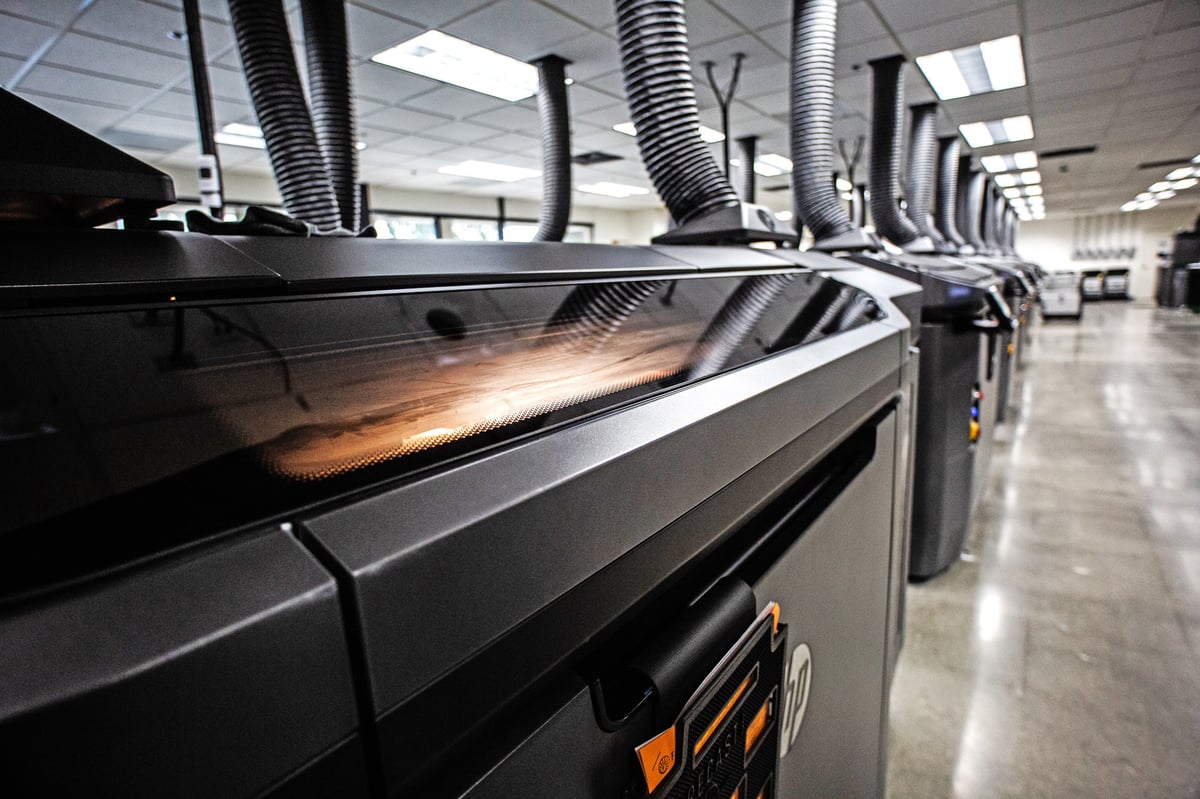Additive manufacturing isn’t just something that Forecast 3D does – it’s in its DNA. Conceived in 1994 by brothers Corey and Donovan Weber, who bet that “3D printing would be something big.” Their additive manufacturing business grew from a single-car garage to occupy more than 49,000-square-feet of a Carlsbad California manufacturing space. Forecast 3D now boasts a workforce of more than 60 3D printers, including Stratasys, Renishaw, 3D Systems, SLM, EOS, and one of the largest fleet of HP multi jet fusion production-capacity 3D printers in the USA.
But what do you do with a fleet of production 3D printers when a global pandemic hits?
Pushing the Limits of Manufacturing Flexibility

In March 2020, when California Governor Gavin Newsom issued a state-wide stay-at-home order in response to the growing coronavirus pandemic, Forecast 3D shut down all of its non-critical production and turned its attention to what the country needed most – biomedical devices, nasopharyngeal swabs, and personal protective equipment.
By supporting critical infrastructure sectors, Forecast 3D did not have to shut-up-shop and, in fact, developed and deployed a range of health products in partnership with Bellus3D, a provider of 3D face-scanning technology, and nasopharyngeal swabs alongside a consortium of companies including Harvard’s Beth Israel hospital in Boston.
The rapid pivot to PPE was so successful that Forecast 3D produced nearly 1.5 million FDA-approved nasopharyngeal swabs, 250,000 face shield head bands, and thousands of mask customization products.
“It has been a commercial success all in all,” says company co-founder Donovan Weber. “We were able to get the cost down very low, to make it commercially viable. We were able to lean out the process.” Forecast 3D developed their own manufacturing processes, removing manual labor and adding automation to bring down production costs and turn additive manufacturing into a competitive manufacturing solution at volume.
Although Forecast 3D has still taken a hit from the pandemic – losing a large chunk of aerospace and prototyping business – where one door closed, another opened for this flexible company.
Healthcare Turns to Additive Manufacturing

The versatility of additive manufacturing enabled Forecast 3D to enter sectors experiencing increased manufacturing demand, such as biomedical device prototyping and production, that had very few traditional manufacturing options offering the speed to market that 3D printing could deliver. “It’s amazing the amount of prototyping and short-run production that we’ve done across the board,” says Donovan. “San Diego is a huge biomedical hub, and it seems that so many of our devices have had some tie to this pandemic.”
The pandemic gave Forecast 3D exposure to industries and companies that would not have previously considered additive manufacturing, Donovan says. “Some of these giant firms, which have been responsible for ordering the nasopharyngeal swabs, have looked at us now, and they value our level of professionalism and engineering, and how we have put processes in place for additive manufacturing.”
Whether it is in the biomedical, aerospace, automotive, or consumer goods sectors, Forecast 3D customers found that the versatility of additive manufacturing enabled them adapt to fluctuating demand, uncertainty, and new technological trends. This is a significant advantage over some conventional manufacturing methods, notes Donovan, where new product development and tooling can require significant financial and time commitments.
In fact, the consumer demand for 3D printing service providers has been growing steadily. In their 2019, “3D printing: hype or game changer?” report, Ernst and Young says that surveyed organizations using service providers had more than tripled and that by 2022, 32% expect to design and produce their AM parts via service providers.
For engineers and designers looking for a service provider, Donovan recommends being flexible. “If your expectations aren’t being met by a particular technology, broaden your search, look at other technologies,” he says.
Designing for Additive Manufacturing

Forecast 3D clients, for the most part, are very knowledgeable about the technology and how to design products for additive manufacturing by combining geometries and reducing assemblies. Yet the company also offers a design service to walk customers through product development and design for 3D printing that can often save time, money, and materials.
“It’s called DfAM, design for additive manufacturing,” says Donovan. “If we’re looking at geometries and we see there’s something we can do to make the geometry more nestable, the economic story can change quickly.”
Even if a company had not designed specifically for 3D printing and is planning to use traditional manufacturing in the long term, they can still benefit from using additive manufacturing for their early-stage production, says Donovan. “Customers can get a product on the market faster, they don’t have to lock in their design, and they don’t have to worry about making tool-safe modifications.”
Besides additive manufacturing and its associated services, a large part of Forecast 3D’s business today is urethane casting, which Donovan views as an evolution of 3D printing. “Urethane casting will be a viable alternative to additive manufacturing for quite a while because of the ability for us to get incredibly clean parts with super high aesthetics in a variety of colors and textures,” he says.
Although Forecast 3D recommends urethane casting for a wide range of custom, short-run parts, it also sees additive manufacturing as especially well suited for production runs of thousands or tens of thousands of parts, manufacturing complex functional parts that are difficult to produce with traditional processes, supplementing in-house manufacturing during peak times, and producing mass-customized goods. “Price per part versus traditional manufacturing methods can be a hurdle, but for some products, the cost can be less once you consider expenses such as tooling, shipping and tariffs,” says Donovan. “We recommend companies that plan to mass produce with additive manufacturing work with us to optimize their design for additive manufacturing early in the innovation process.”
Another service at the shop on the rise is 3D metal printing. In the future, “additive laser metals and metal jet will be key for us for sure,” says Donovan. “Metal jet will bring the cost [of 3D metal printing] down.”
Next Steps: Metal 3D Printing on Demand

It’s no wonder that Forecast 3D is betting on metal after being acquired last year by the world’s largest producer of metal powder, UK-based GKN. The acquisition gives the company a global view and access to more technologies. “Forecast 3D is a perfect fit,” says GKN’s CEO Peter Oberparleiter. “They are everywhere we aren’t – geographies, markets, technologies, and base materials. Combining our individual capabilities will present unparalleled advantages to our customer bases and enable us to cross-promote additive manufacturing in metal and plastic over more diversified markets. It is an important step on our journey to become number one in this high-growth market.”
Alongside GKN Additive, Forecast 3D has ambitions to be the leading global additive manufacturing company in the production space, with a global network of manufacturing centers. “We plan to continue to expand our 3D manufacturing capabilities in North America and Europe, as well as expansion into Asia and South America,” says Donovan. With an expectation that post-pandemic growth in additive manufacturing will resume, this additional global capacity will allow Forecast 3D to keep up with demand.
The Weber brothers bet on 3D printing in 1994 has brought them a long way from their garage in Carlsbad. And if their intuition about the technology holds true, the industry can expect to hear a lot more about Forecast 3D in the coming years.
“We don’t just bring customers cutting-edge advancements in technology,” explains Donovan, “we’re excited about this technology and what it can do. We’re using it to completely revolutionize the way our customers approach product development and manufacturing.”

License: The text of "3D Printing Service Forecast 3D Finds Opportunity in Lockdown" by All3DP Pro is licensed under a Creative Commons Attribution 4.0 International License.
